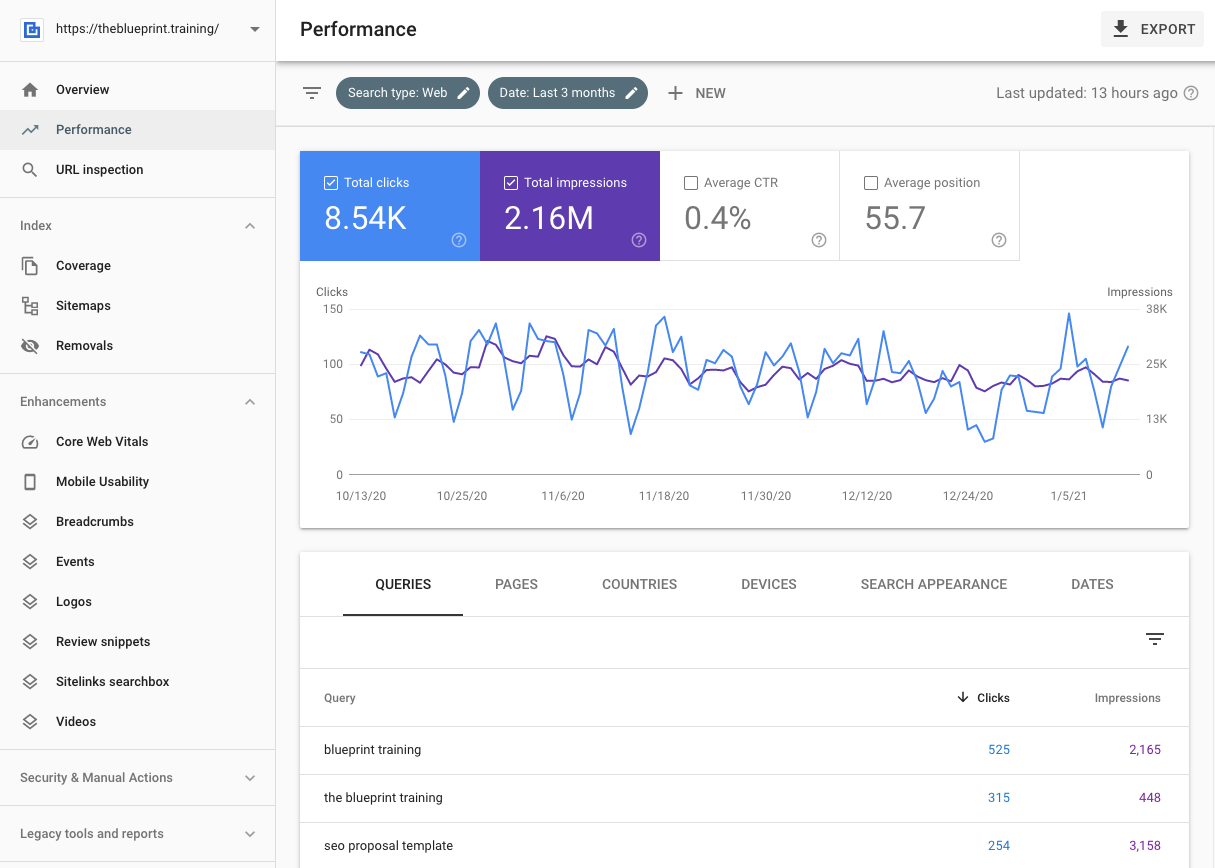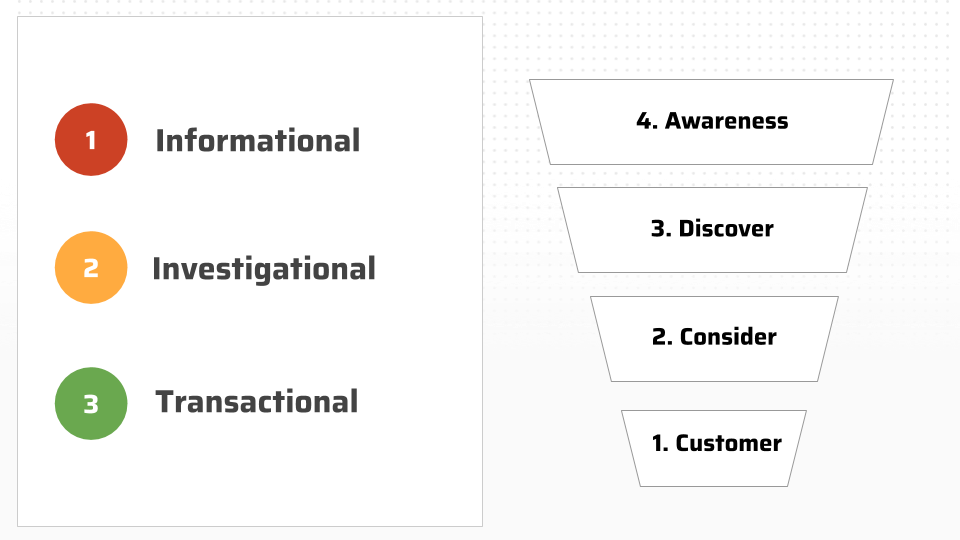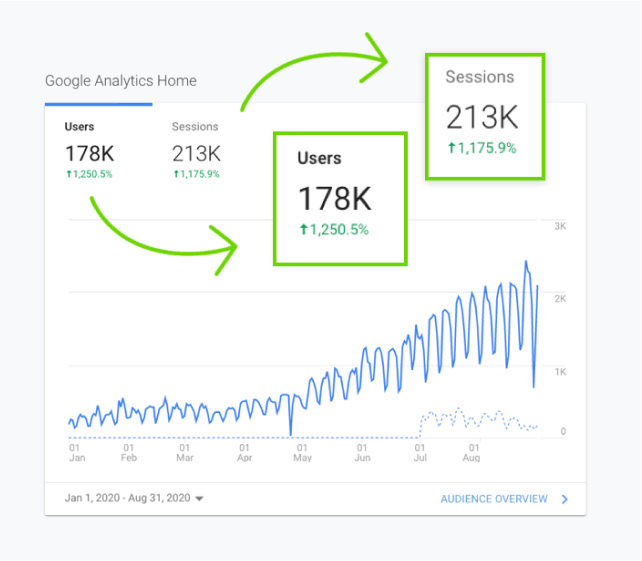Table of Contents
Keywords are the foundation of a great SEO campaign. Targeting the wrong keywords will cost your company a lot traffic and revenue.
We like to break keyword research into 2 sections:
- Finding keywords for existing pages on your website
- Finding keywords you can develop new content around
In this post, we’ll focus on finding keywords for the existing pages on your website.
I’ll be covering:
- The end to end keyword research process
- The templates and tools needed
- Selecting the optimal keywords for a site
- How to put your keywords to work to drive revenue
Let’s get into it!
WATCH OVER MY SHOULDER AS I PERFORM KEYWORD RESEARCH 👀
Keyword research process overview
We’re a process oriented agency – everything we do for clients follows a detailed process. This ensures both speed and quality of keyword selection.
Our keyword research process is as follows:
- Review existing pages on the website to identify the “Main KW” for every page
- Review existing pages on the website to identify the “Secondary KWs” for every page. These keywords support the “Main KW” by adding contextual support as well as “long tail” searches to the page
- Review the top 3 SERP results (in Google) for each of the “Main KWs” to understand the type of content Google wants to rank for that query (i.e. searcher intent + content type)
- Review the referring domains of the top 3 SERP results (in Google) for each “Main KW”. This helps us to understand the competition for each query we want to rank for
- Analyze the results and prioritize accordingly
The keyword research template
You can get access to the template through our Goodie Bag:
⚠️ GRAB THE KEYWORD RESEARCH TEMPLATE HERE ⚠️
This template is a BEAST, let’s walk through it.

The first 7 columns are pulling data from our Website Quality Audit, us context into the page’s performance.
The following 4 columns is where we’ll perform the keyword research (more on that soon).

The next part gathers data from the SERPs on the top 3 websites ranking for each keyword.
This data is critical to help us understand what it will take to rank by telling us exactly what Google wants to rank for each query we’re targeting.
- The type of page ranking (product page, blog post, Amazon listing, etc) helps us formulate the type of content to create for each Main keyword
- The collective authority to the top 3 results helps us understand how much effort we’ll need to place on link building
Gathering this data is a bit of a manual slog, so we’ve trained an offshore team on the heavy lifting.

We also wrote some nifty formulas to calculate keyword “opportunity” scores to help determine the level of effort to rank.
If you’re a spreadsheet nerd like us, this file is amazing. If you’re a client, it’s overwhelming.
To make this easier to digest we simply create charts using the data. We then drop it into a presentation deck to send with our findings, recommendations and the data.


This deliverable template makes it easy to have conversations with clients who have unreal expectations about the results of their campaigns.
For example, we had a client in the loans industry – one of the most competitive niches. They hired us wanting to rank 1st keywords like “sba loans”. After completion of this exact file, we were able to deduce:
- It would take them years to rank (if ever) 1st for “sba loans”
- Long form content (i.e. “SBA Loans: Are You Qualified?”) was dominating the SERPs, we’d have to pivot the focus from landing pages to blog content to get the fastest results
If we went to the client without this data, they’d have fired us on the spot. You can’t argue with data – they bought in to our plan and as a result increased organic traffic 120% in 10 months.
Now that we’ve covered the template, let’s talk about how to populate it with the optimal keywords.
How to do keyword research
While there’s amazing tools out there to help you, keyword research is still a time consuming process. There’s no hacks or shortcuts, we need to put in the time doing, well, research.
We don’t want to just identify a handful of keywords, we want to identify (and understand) all the keywords that will make the page contextually relevant. That’s why we structure our keyword research documents to discover 2 types of keywords:
- The “Main” keyword. The focus keyword for the page – this generally has the most relevant intent and highest search volume. This keyword drives the main targeting of the page.
- “Secondary” keywords. The “long tail” keywords that support the “Main” keyword and give the page opportunity to rank for additional search queries.
Finding the “Main” keyword
Keyword research is essential when you onboard a new client, particularly if they work in a niche you have no experience in. Before you can get to work, you need an idea of what keywords you’re going to target through the campaign.
Bear in mind, keyword research can be a bit dry. You’re going to deal with long lists of search terms, narrow down the keywords you want to use, discard those with little value, and so on.
The good news is we already laid some groundwork for understanding your client’s industry during the discovery process. Now, we need to narrow things down even further. Here are some questions to get you started:
- What keywords have you tried using in the past?
- Who’s your target audience?
- Who are your primary competitors?
- What regions do your products/services target?
You can get a lot of this information yourself just by visiting your client’s website. However, it’s always interesting to find out if your client’s ideas match what is actually going on with their business.
It’s all too common to deal with customers that have been going about targeting the wrong keywords, either because they choose options that are too competitive or they don’t have enough search traffic.
The keyword research process may be dry, but it gives you the data you need to make smart decisions.
Now, there are a lot of tools you can use to identify keywords. Most of them will throw hundreds of options at you. One of the tools we most commonly use is Google Search Console.

If you have access to Search Console, you can hop over to the Performance tab and look for the Performance section. Search Console will show you the top queries driving traffic to your website, including clicks and impression data.
What your main keywords are should be evident – they’re the ones getting you the majority of your clicks. In some cases, we find that clients have never looked at this data and they have no idea what keywords are driving the majority of their traffic. In other words, they’ve been driving blind.
If you don’t have access to Search Console, we can also recommend using Google Keyword Planner, Google Ads, and SEMrush. Which tool you use doesn’t matter all that much since you’ll end up with basically the same data.
Case study: Selecting the “Main keyword” for home pages
MoonClerk is an online payment platform that helps businesses accept payments, specifically recurring payments (such as gyms and personal trainers).
Our keyword research file turned up 2 “Main” keywords for the home page: moonclerk and recurring billing software.
There’s a lot of debate in the SEO community about home page keyword targeting – should it be brand focused or keyword driven?
My answer is both.
A home page has incredible ranking power, you should always aim to combine your brand with your main keyword.

Finding the “Secondary” keywords
There’s some amazing keyword research tools out there, but none better than Google. If you type your keyword into Google, you get 2 awesome keyword sources:
- A list of the websites ranking for your Main keyword
- A list of related searches
We can use both of these to mine Secondary keywords.
1. Stealing from the websites ranking for your Main keyword
Search Google for your Main keyword. Take the 1st URL that appears (organic listings, not ads) and enter it into Ahrefs (or SEMrush). The tool will report all the additional keywords and search volume that page is ranking for.

Rinse and repeat with organic results 1 – 4 and gather these keywords as the seedlings for your Secondary keywords.
2. Using Google related searches
Search Google for your Main keyword. Scroll to the bottom of the page and you will see Google’s related searches. These tell us what people are also looking for when searching for your Main keyword. These always serve as some of the best Secondary keywords.

If you install the Keywords Everywhere Chrome browser plugin, you will also see the associated search volumes in the related searches.
Picking Secondary keywords
Do NOT mistake Secondary with synonyms or semantic keywords.
A synonym keyword would be the Main keyword, just stated in a different order like “Billing software that’s recurring”. These have no value to us here.
According to SEMrush, semantically related keywords are simply words or phrases that are related to each other conceptually.
For a keyword like “search volume,” some semantically related keywords could be:
- keyword research
- paid search
- online marketing
For a keyword like “cook asparagus,” some semantically related keywords could be:
- vegetable peeler
- lemon juice
- baking sheet
Semantic keywords are valuable, but not here – we’re simply trying to find keywords that support the Main keyword, contextually.
In other words, what are the additional keywords we need to add to tell Google this page is truly about the Main keyword?
Let’s look at some examples.
Main keyword = Miami SEO agency
Secondary keywords =
- SEO consultants in Miami
- Results focused SEO agencies
- SEO agency pricing
- Reputable SEO firms in Miami
And another example…
Main keyword = criminal court process in Denver
Secondary keywords =
- Denver criminal court
- Colorado rules of criminal procedures
- How to prepare for a criminal court appearance
- Order of events in a criminal trial
- Recent criminal defence wins in Colorado
It’s easy to picture how those secondary keywords could become H2 headers within your pages. They can help support the Main keyword and provide context. That means your content becomes both more informative and it gets more love from search engines – what’s not to like?
Understanding Secondary keywords is the perfect segway into mapping keyword intent.
Mapping keyword intent
“Intent” refers to what the searcher is really looking for when using keywords.
Intent is critical because it represents the user’s state of mind and it gives you insight into what type of content you want to rank for with that query. In the example above, for example, we assigned the “criminal court process” keyword to the “Discover” funnel stage.
Why? It’s a broad search that doesn’t indicate any intent to convert. At that stage, the user is still taking in information. Now take a look at stage two – it’s more specific, which means the user already has an idea of what they want and now they’re entering the consideration stage of the funnel.
That example shows you a few of the journey stages we like to use. In full, we like to map intent based on 5 journey stages that make up a keyword tunnel:
- Customer. Keywords that your current customer based is looking for – this is generally support based or usage queries (i.e. how to use “product” or service).
- Consider. Already aware of the options and looking to convert.
- These are pre purchase queries (best, reviews, top) and specific events ex. “men engagement rings”, “Rolex watches reviews”, “top places to live in Florida”.
- Keywords with clear purchase intent (cheap, buy, for sale) ex. “cheap gold watches”, “coffee mugs buy in bulk”, “protein powder wholesale”. These keywords also include local services, main services and branded search ex. “carpet cleaner in New York”, “app design company”, “quest bars”.
- These keywords will always map to product pages, category pages or the homepage.
- Discover. Coming across your product or service offerings for the first time.
- Inquisitive keywords (who, what, where, how) ex. “where are Rolex watches made”. These keywords usually map to expert guides type of content.
- Awareness. In the market for a solution, but have no idea who you are or what you sell.
- Very broad keywords ex. “gold watches” “deserted islands”, “blue couches”. These keywords can map to either product pages or content pages.
The goal is to scrape as much of the SERPs as possible, even for the high level attention based keywords that don’t drive conversions. The more free, organic exposure we can get your brand, the better.

Analyzing Top 3 SERP Results
This part is optional, but highly suggested – especially if you’re doing SEO for clients.
We analyze the top 3 search results ranking for each of the “Main” keywords. That enables us to know if our page has a legitimate shot of ranking for that keyword by comparison. If not, we determine the proper way ahead to capture that traffic. For each “Main” keyword we:
- Scrape the top 3 results in Google. We manually pull the first 3 results in Google for a specific keyword using Ahrefs.

- Check DA and PA. We check the Domain Authority and Page Authority of the top results. We use this data at the end of the analysis to formulate an accurate and realistic scenario of the opportunity that each page has to rank for the targeted keyword.
- Check the number of links pointing to each of those results. We look for the amount of dofollow referring domains in the live index of the page. This helps us understand how many links the top results have, and gives us a better idea of how much work it would take to compete with it.
- Check the “link velocity” of each result. This tells us how many links that page is generating on a monthly basis.

- Assess the “content type” of each result. We need to understand if Google is ranking blog posts, product pages, Amazon listings, YouTube videos, etc for your main keywords. This helps us understand what Google wants to show for your keywords.
Crosswalk data against your site’s metrics
Having the data for our competitors, we can crosswalk that information against your site’s metrics:
- Current ranking for that keyword.
- Current number of referring domains to that keyword’s page.
- Client’s domain authority.
- Client’s page authority.
We have an in-house formula that helps us calculate an opportunity score for each keyword and page. These are the variables the formula includes:
- DA Average: Domain Authority average across top 3 results.
- PA Average: Page Authority average across top 3 results.
- Link Average: Referring domain average across top 3 results.
We’re not going to share the formula since that’s proprietary (sorry!) but we can tell you the kind of metrics we get from it. In any case, once you have the competitor data we mentioned before, determining an opportunity value won’t take much work.
Based on those variables and the client’s site metrics we develop the following Opportunity Scores metrics:
- DA Opportunity Score: this formula has the ability to compare DA Average against client current DA and return opportunity scores between 100 (highest opportunity to rank) and 0 (lowest opportunity).
- PA Opportunity Score: comparison of PA Average against client current PA and return opportunity scores between 100 (highest opportunity to rank) and 0 (lowest opportunity).
Having these two Opportunity Scores we can calculate our final Ranking Opportunity Score, which takes into consideration our main data points: DAOS, PAOS, and current ranking. Scores between 100 (highest opportunity to rank) and 0 (lowest opportunity).
These scores help us to prioritize the next steps in the process:
- How many links to build to that page.
- How often to build links to that page.
- The necessary “on-page corrections to make.
Ok, take a deep breath – I know this is confusing to read, but I told you before we automated this whole file for you. All you have to do is find the keywords and enter the data, the rest will take care of itself.

